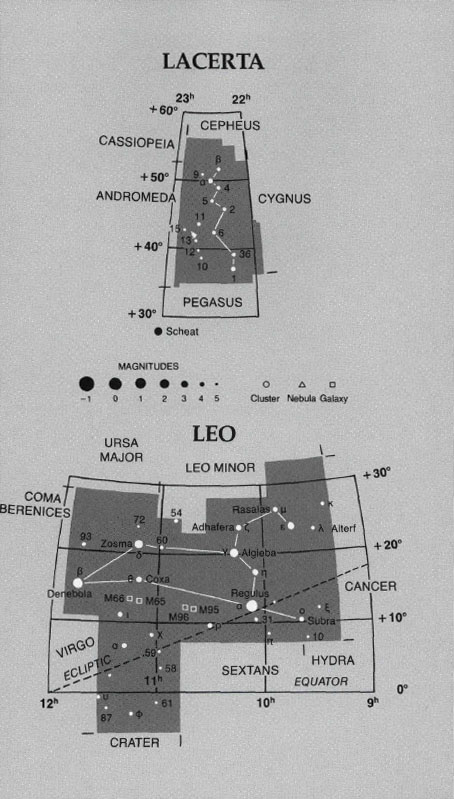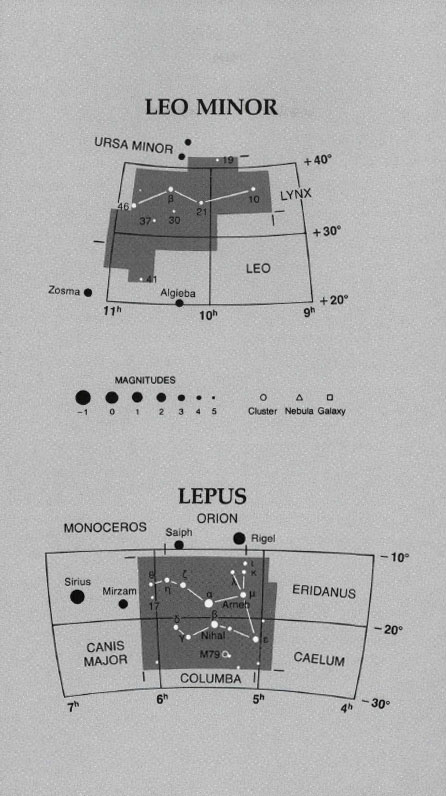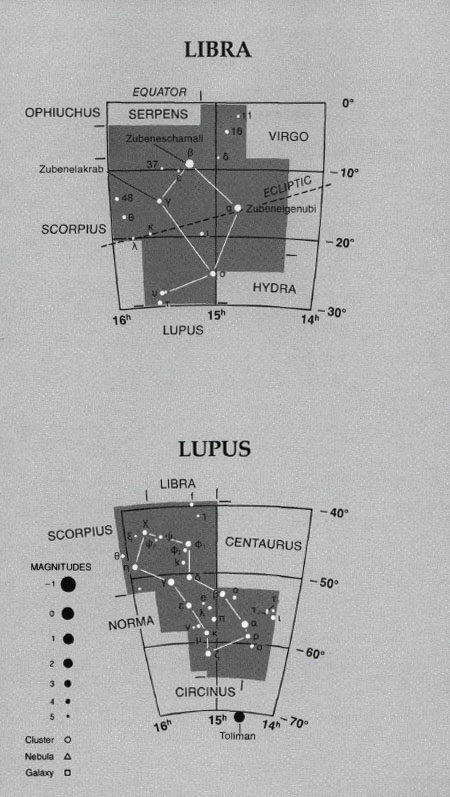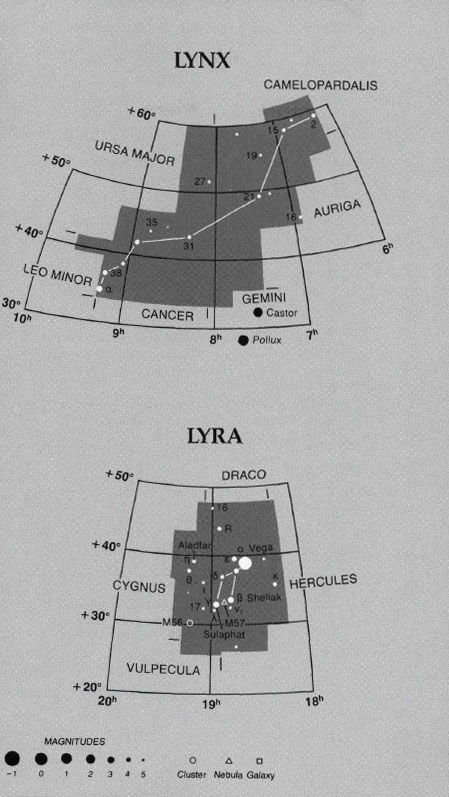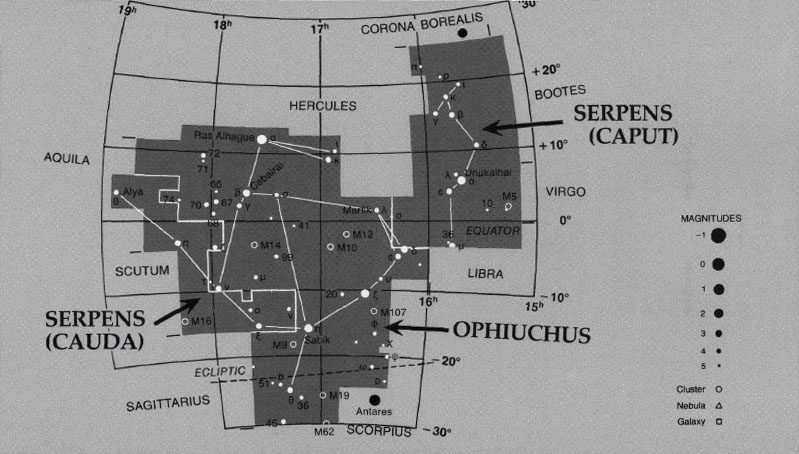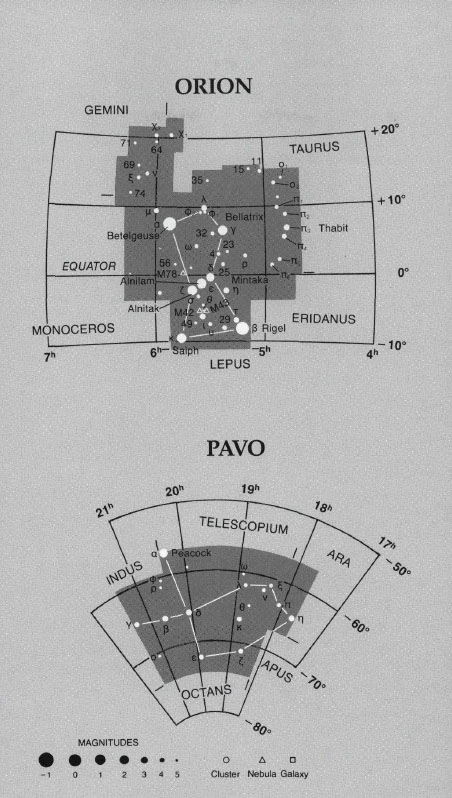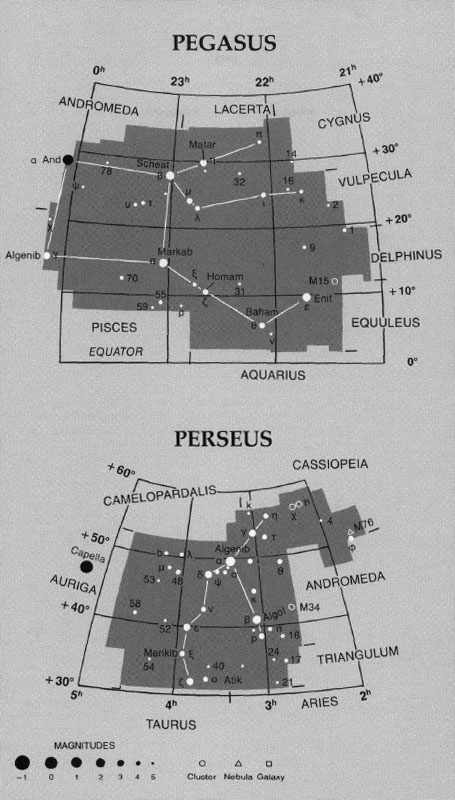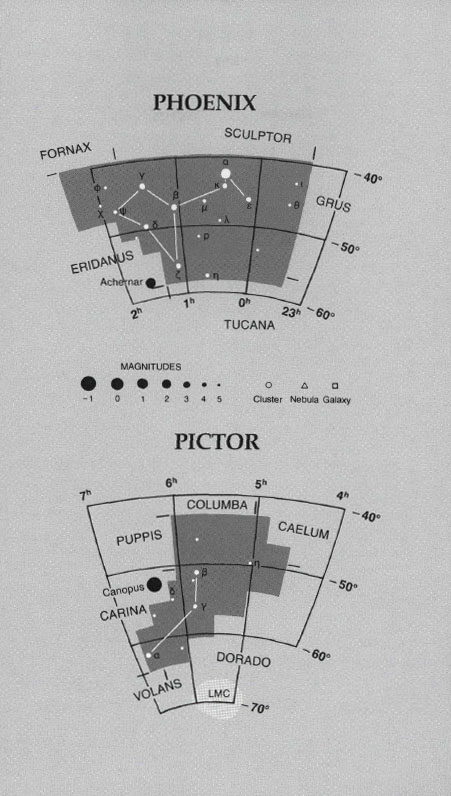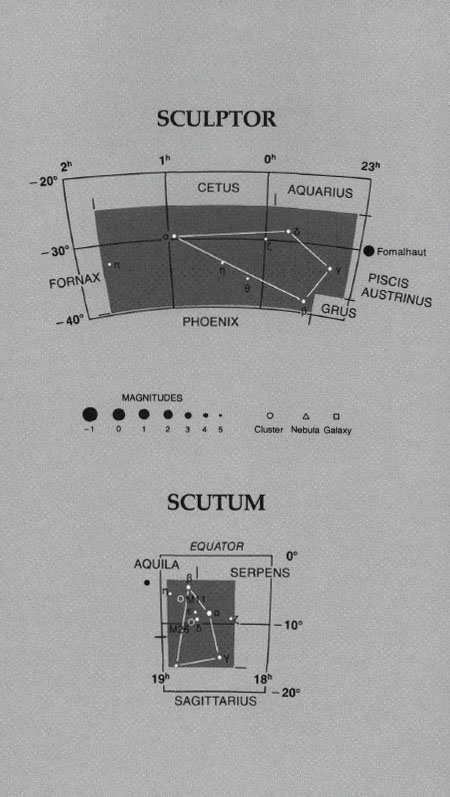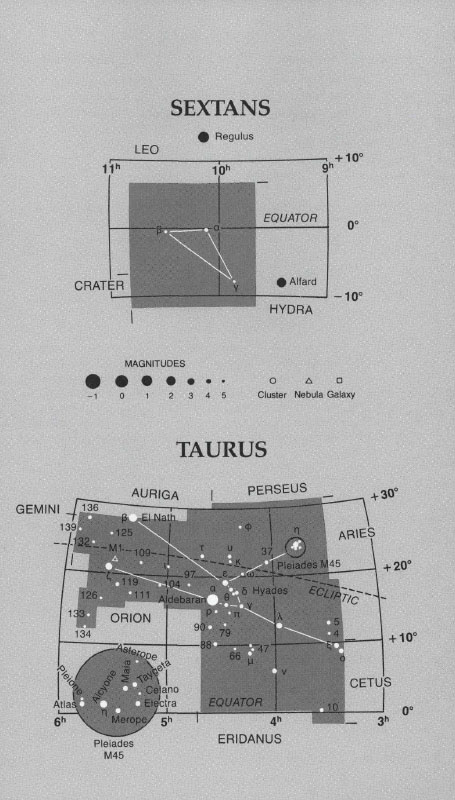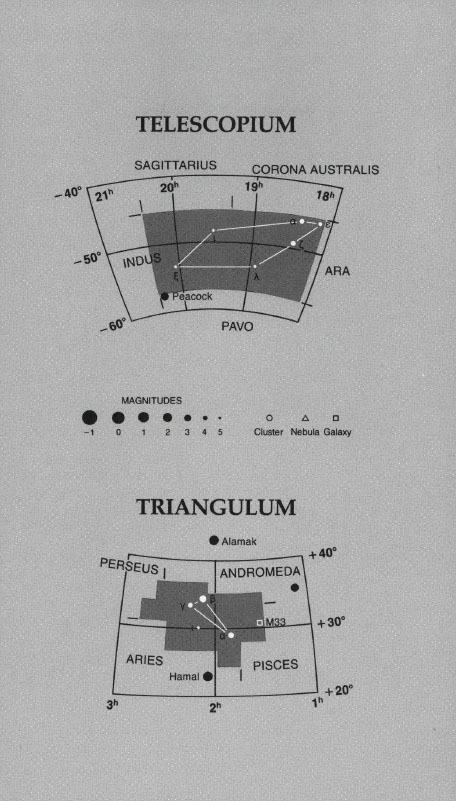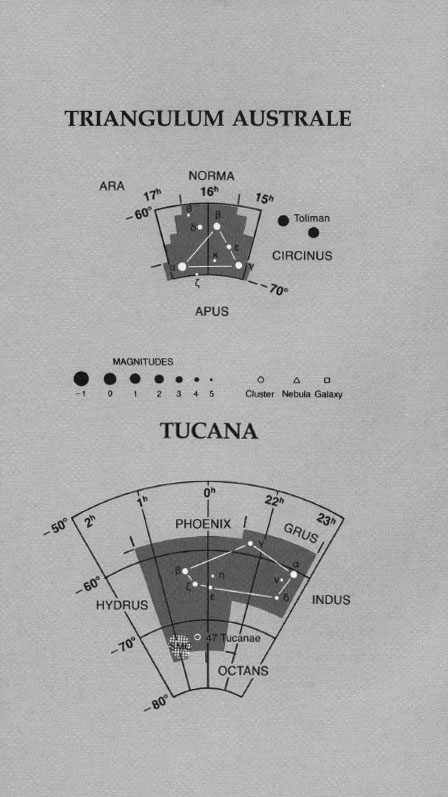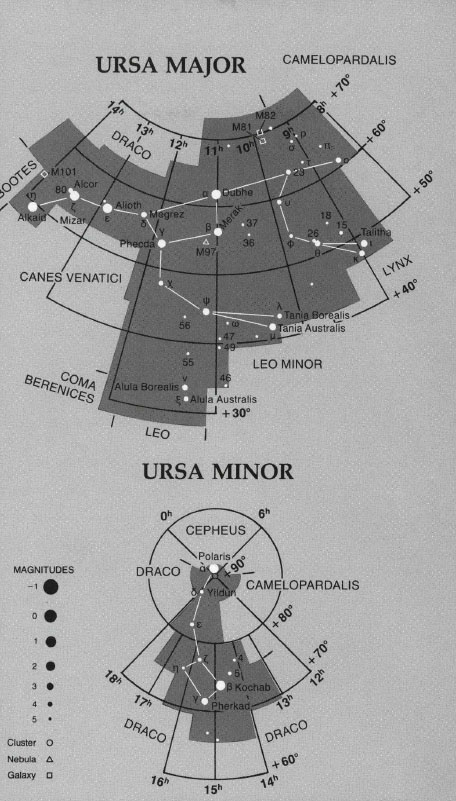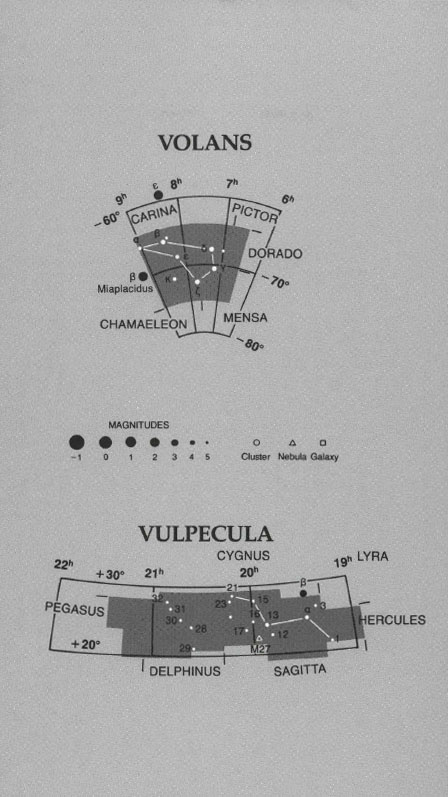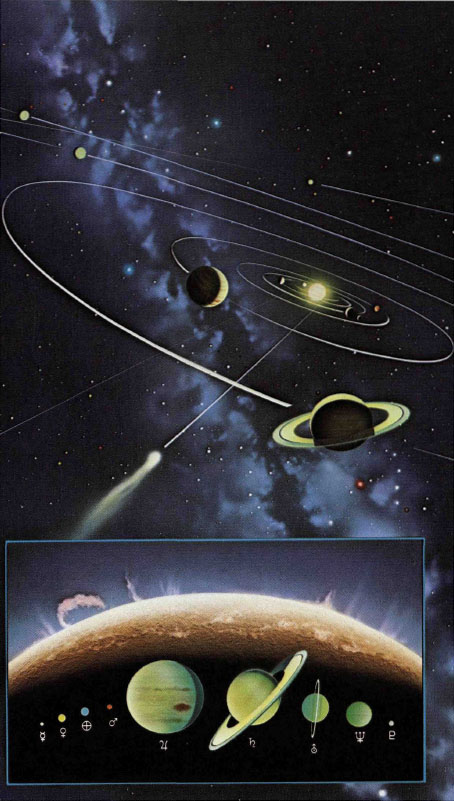HYDRUS
 Hydri Hyi The Small Water Snake
Hydri Hyi The Small Water Snake
Hydrus (not to be confused with Hydra) is a faint constellation close to the south celestial pole. Its tail reaches due north almost to Achernar (a Eri), and the best way to find it is to find that bright star first. Just outside Hydrus’ boundaries to the east are the constellations Mensa and Dorado, which contain the Large Magellanic Cloud. Just outside to the west, in the constellation Tucana, is the Small Magellanic Cloud. Bayer figured Hydrus in his atlas to fill empty space in the southern hemisphere.
α is of magnitude 2.84, 31 lt-yr away, and of spectral type F0 V.
β, a Gl IV star of magnitude 2.78, is 21 lt-yr from Earth.
γ is an M2 giant, of magnitude 3.30, and 300 lt-yr away.
δ, an A2 star of 4.26 magnitude, is at a distance of 72 lt-yr.
ε, a B9 star of magnitude 4.26, lies at a distance of 191 lt-yr.
ζ, an A2 star 652 lt-yr away, is of apparent magnitude 4.90.
η is a double star. The brighter component is a G5 star of magnitude 4.72, at a distance of 125 lt-yr.
V is a 4.70-magnitude K6 star at a distance of 297 lt-yr.
INDUS
 Indi Ind The (American) Indian
Indi Ind The (American) Indian
This is another of the constellations figured by Bayer to fill the southern sky. It contains no bright stars. It is best found by locating the constellation Pavo, the Peacock. Indus is just to the east.
α is a giant K0 star, 84 lt-yr from Earth, of magnitude 3.11.
β is a K2 star of magnitude 3.72 at 270 lt-yr.
δ is 190 lt-yr away, with a magnitude of 4.56 and spectral type F0.
ε is perhaps the most interesting star in this constellation. At a distance of only 11.2 lt-yr, it is the 13th-nearest star to our solar system. It is a K8 main-sequence star of magnitude 4.68.
LACERTA
 Lacertae Lac The Lizard
Lacertae Lac The Lizard
For ancient Chinese astronomers, this relatively faint group formed part of a Flying Serpent (the rest consisting of the group we call Cygnus). Lacerta was formed by Hevelius to fill space between Cygnus and Andromeda. For Lacerta he used also the name Stellio (from Latin Stella, “star”), referring to a kind of Mediterranean newt with starlike dorsal spots. Lacerta has no notably bright stars.
α is a magnitude-3.85 star of type A0, at 91 lt-yr.
β, a gK0 star of magnitude 4.58, is at a distance of 172 lt-yr.
1 Lac is a 4.22-magnitude star of type gK4, 325 lt-yr off.
4 Lac is a cB8 star of magnitude 4.64, at 1,100 lt-yr.
5 Lac, a cK6 star 1,100 lt-yr away, is of magnitude 4.61.
LEO
 Leonis Leo The Lion
Leonis Leo The Lion
The Lion is one of the longest-recognized of the constellations. Ancient Persians, Turks, Syrians, Hebrews, and Babylonians all saw a lion here. In Greece this was the Nemaean lion slain by Hercules in the first of his labors. The Egyptians worshiped these stars because the Sun was in this part of the sky in summer at the time of the annual lifegiving Nile flood. Many observers look not for a lion but for the famous Sickle and the triangle that forms the Lion’s hindquarters. The Sun is in Leo from August 12 to September 17.
α is Regulus, “little king,” so named by Copernicus. It is the heart of the lion—the “dot” of the reversed question mark (otherwise known as the Sickle). Regulus is a B7V main-sequence star, magnitude 1.35, 85 lt-yr away.
β is Denebola, “tail of the lion,” an A3V star 42 lt-yr away, magnitude 2.14.
γ, Algieba, is “the lion’s mane”—a spectacular double star, separated by 4”, with a combined magnitude of 1.99, at 90 lt-yr. The stars, types G5 and K0III, appear yellow and green in a small telescope.
δ, Zosma, is “the girdle” of the lion. It is a 2.57-magnitude star, type A4V, at 82 lt-yr.
ζ, Adhafera, is a giant F0 star of magnitude 3.46 at 130 lt-yr.
θ, Coxa, “the hip,” is an A2 star, magnitude 3.34, 90 lt-yr distant.
ν, Alterf, is a gK5 star 180 lt-yr away, magnitude 4.48.
μ, Rasales, “the eyebrows,” is a star of magnitude 4.10, type gK3, at 155 lt-yr.
M65, M66, M95, and M96 are 9th- and 10th-magnitude galaxies, all spirals, visible through a small telescope.
LEO MINOR
 Leonis Minoris LMi The Small Lion
Leonis Minoris LMi The Small Lion
This small constellation lies just under the hindfeet of the Great Bear and just over the sickle of Leo. In Arab folklore it was a gazelle with her young; in China, part of a dragon or chariot. In modern times it was named by Hevelius. Leo Minor has no very bright stars.
β is a gG8 star of magnitude 4.41, at a distance of 190 lt-yr. It is not the brightest star in this constellation—46 LMi is. There is no α star.
46 LMi is sometimes called o, the only other Greek letter assigned in this constellation. This 3.92-magnitude sgK2 star is 102 lt-yr away.
10 LMi is a gG6 star of magnitude 4.62 at a distance of 172 lt-yr.
21 LMi is a 4.47-magnitude A5 star, 120 lt-yr distant.
LEPUS
 Leporis Lep The Hare
Leporis Lep The Hare
Since the hare was one of Orion the Hunter’s favored animals for the hunt, it is placed in the sky just beneath Orion’s constellation. Some folklores saw this as the “rabbit in the Moon.” To the early Egyptians the stars α, π, ε, β were the “Boat of Osiris,” the god with whom Orion was identified. The Arabs thought of it as four camels drinking from the River Eridanus.
α is Arneb, from the Arabic for “rabbit.” This is an F0 Ib star, at a distance of 900 lt-yr, magnitude 2.58.
β is Nihal, Arabic for “camels drinking.” This is a double, the primary being of magnitude 2.81, spectral type G5 III, at a distance of 113 lt-yr. The 9.4-magnitude companion is 3” away.
ε is a K5 III star of magnitude 3.21 at 170 lt-yr.
μ is a B9 giant star, magnitude 3.29, at 390 lt-yr.
R Leporis, not marked on the chart, lies due west of the star π, on the border of Eridanus. R Lep is called “Hind’s Crimson Star” for its discoverer and its magnificent red color. It is a variable, ranging from 6th to 11th magnitude in a period of 436 days. R Lep can be found with binoculars when near maximum brightness.
M79 is a 7th-magnitude globular cluster, good for a small telescope.
LIBRA
 Librae Lib The Scales
Librae Lib The Scales
As the names of the stars show, for the Greeks this constellation used to be the claws of the Scorpion. Later added by the Romans to the zodiac, this star group is said to have been called The Scales because in classical times the autumnal equinox (when days and nights are “in balance”) occurred. Today the Sun is here from November 1 to November 23. Libra is next to Virgo, who is sometimes pictured as Astraea, the goddess of justice, holding The Scales.
α, Zubenelgenubi, “the southern claw of the scorpion,” is a double star, the primary having a brightness of 2.76, spectral type A3. The secondary, with a separation of 231”, is of magnitude 5.15. The system is at a distance of 66 lt-yr.
β, Zubeneschemali, is “the northern claw of the scorpion,” a 2.61-magnitude star of spectral type B8 V, 140 lt-yr away.
γ is Zubenelakrab, “scorpion’s claw,” a giant G6 star of magnitude 4.02 at 109 lt-yr.
δ is an Algol-type semi-detached binary system. One star orbits the other so closely that they almost touch. They are of combined magnitude 4.8, 100 lt-yr away, of types A0 and dG2, 2.6 and 1.1 solar masses, respectively, and each is 3.5 times the size of the Sun. The orbital period is 2.33 days.
LUPUS
 Lupi Lup The Wolf
Lupi Lup The Wolf
Classical Greeks and Romans generally knew this star group simply as a wild beast, of a kind unspecified. Eratosthenes saw it as something totally different: a wineskin, held by Centaurus. One classical legend says this was the wolf into which Lycaon was turned by Zeus for the crime of serving human flesh at a banquet for the gods. The Arabs saw in this area of the sky a leopard or a panther.
α is a variable with an average magnitude of 2.32, spectral type B1V, 430 lt-yr away.
β is a B2IV star of magnitude 2.69 at 540 lt-yr.
γ is a close double (separation 1”) appearing as a B2V star, 2.80 magnitude, at 570 lt-yr.
δ is 680 lt-yr away, of spectral type B2IV and magnitude variable around 3.21.
ε is a B3 star, 540 lt-yr off, magnitude 3.74.
ϕ1 is a K5 star 272 lt-yr distant, of magnitude 3.59.
ϕ2 is a B3 star, 816 lt-yr away, of magnitude 4.69.
LYNX
 Lyncis Lyn The Lynx
Lyncis Lyn The Lynx
These faint stars, below Ursa Major, were depicted as a constellation by Hevelius in 1690. Since the area contains no bright stars, those who wish to see the constellation must be lynx-eyed.
α is an M0 III giant star of magnitude 3.17, 180 lt-yr from Earth.
38 Lyn is double (separation 2”.9) appearing as a B9 star of 3.82 magnitude, 109 lt-yr away.
31 Lyn is a gK5 star, magnitude 4.43, at 217 lt-yr.
LYRA
 Lyrae Lyr The Lyre, or Harp
Lyrae Lyr The Lyre, or Harp
In this small, beautiful constellation the six brightest stars form a parallelogram with a triangle at one corner. Vega, third-brightest star in the sky, forms one corner of the triangle. Ancients in India saw here an eagle or a vulture. Early Greeks saw it as their lyre, often with the body formed from a tortoise shell (from which, some thought, the first lyre was contrived). Old Greek legend claims this is the lyre of Orpheus, musician of the Argonauts and husband of Eurydice, and that the lyre was placed in the sky to commemorate the beautiful music it produced at the hands of Orpheus.
α is Vega, or Wega, “eagle” in Arabic. Spectacularly bright, it passes high over cities near lat. 40°N. Blue-white, of magnitude 0.04 and spectral type A0 V, it is one of the few bright stars that are not giants or supergiants. Vega is 26 lt-yr away. Our solar system is moving toward it at about 19 km/sec.
β is Sheliak, Arabic for “tortoise.” This is an eclipsing binary—magnitude 3.38-4.36, period 12.9 days. The components are of spectral types B2 and F, 1,300 lt-yr away. This double shows a peculiar spectrum, for each star is throwing off a stream of gas which spirals around it. The American astronomer Otto Struve spent so much of his career studying this system that it is sometimes jokingly referred to as “Beta Struve.”
γ is Sulaphat, another Arabic name for “tortoise.” It is a B9III star of magnitude 3.25, at 370 lt-yr.
ε is a famous “double double.” In binoculars (and to a very sharp eye) it is a pair, ε1 and ε2, of magnitudes 5.1 and 4.4, respectively, 208” apart. A good small telescope can split each—ε1 into stars of 5.4 and 6.5 magnitude, 2”.7 apart, with an orbital period of 1,200 years, and ε2 into stars of 5.1 and 5.3 magnitude, 2”.3 apart, with an orbital period of 600 years.
M57 is the famous “Ring Nebula,” a planetary nebula 5,000 lt-yr away. A small telescope is required to see it, since it is 9th magnitude. The central star which threw off this sphere of gas is 15th magnitude, at the center of the ring. A large telescope is required to see it.
MENSA
 Mensae Men The Table Mountain
Mensae Men The Table Mountain
This was originally named Mons Mensae, the “table mountain,” by Lacaille, referring to Table Mountain (often cloud-capped) above Cape Town, South Africa. He placed it near the south celestial pole, next to the obscure constellation Octans. Later the “Mons” was dropped, so that sometimes this constellation is called merely “the table.” It contains no bright stars, but at its border is the Large Magellanic Cloud.
α is a dG6 star of magnitude 5.14, at a distance of 28 lt-yr.
β is in the Tarantula Nebula. The star has a magnitude of 5.30 and is of spectral type G8. It is 136 lt-yr away.
γ is 220 lt-yr away, of spectral type K4 and magnitude 5.06.
η, of magnitude 5.28, is a type K6 star at a distance of 192 lt-yr.
μ is a B9 star of magnitude 5.69—distance undetermined.
MICROSCOPIUM
 Microscopii Mic The Microscope
Microscopii Mic The Microscope
Lacaille figured this faint constellation south of Capricornus and east of Sagittarius. Composed of 5th-magnitude stars, it was intended to complement the new constellation Telescopium, nearby. These constellations were originated by Lacaille to commemorate the exploration of the microcosm and the macrocosm—the smallest and the largest aspects of the universe.
α is a star of 5.00 magnitude, spectral type G6. It is 365 lt-yr from our solar system.
γ is a G4 star, 230 lt-yr away, of magnitude 4.71. At one time it was part of Piscis Austrinus.
ε is an A0 star, 112 lt-yr away, of magnitude 4.79. It, too, was once part of Piscis Austrinus.
MONOCEROS
 Monocerotis Mon The Unicorn
Monocerotis Mon The Unicorn
This constellation, figured probably by Bartsch, straddles both the celestial equator, just east of Orion, and the galactic equator, which passes close to the stars 13, 18, and 19, cutting the celestial equator at a 67-degree angle. It contains no very bright stars.
α is a star of magnitude 4.07 and spectral type gK0. It is 180 lt-yr from Earth.
β is a telescopic triple star, with 5th-magnitude components separated by 7” and 10”. Two of the stars are of type B3 and are 470 lt-yr away.
γ is a star of magnitude 4.09 and spectral type K2. It is 250 lt-yr from the solar system.
δ is a 4.09-magnitude A0-type star at a distance of 180 lt-yr.
15 Mon is a variable star (about 4.2 to 4.7 magnitude) known also by the designation S Mon. Of spectral type 07, it is 408 lt-yr away.
M50 is a 7th-magnitude open cluster for a small telescope.
NGC 2244 is visible to the unaided eye as a beautiful open cluster in the form of a rosette. Relatively young as stars go, it is 5,300 lt-yr away. For better viewing, try binoculars.
MUSCA
 Muscae Mus The Fly
Muscae Mus The Fly
Bayer depicted this inconspicuous star group as a bee. Later Lacaille depicted it as a fly. It was said to be a match for the Northern Fly, Musca Borealis, once placed on the back of Aries, but now not recognized as a constellation. Musca lies just south of Crux, the Southern Cross.
α is a slightly variable star of magnitude 2.66 to 2.73 and spectral type B2IV. It is at a distance of 430 lt-yr.
β is a double star whose components are of magnitudes 3.7 and 4.0, shining with a combined light of magnitude 3.06. They appear as a B2V star, 470 lt-yr away. Since the components are separated by only 1”, very good seeing is required to split the pair with a small telescope.
δ is a K2 star of magnitude 3.63 at a distance of 155 lt-yr.
NORMA
 Normae Nor The Carpenter’s Square
Normae Nor The Carpenter’s Square
Originally this was Norma et Regula, the Latin for “carpenter’s square and level.” (From Latin norma, “rule,” we get our word “normal.”) These tools, along with nearby Caelum and Circinus, were for use in the Sculptor’s workshop. Located north of, and adjoining, Triangulum, Norma was formed by taking some stars from Ara and Lupus. The region is very rich in celestial objects for binoculars or a low-power telescope.
δ is a 4.84-magnitude star of spectral type A3, at a distance of 230 lt-yr.
ε is a B5 star of magnitude 4.80, at 650 lt-yr.
η, a 4.74-magnitude star of spectral type G4, is 190 lt-yr away.
γ, is a supergiant G4 star of magnitude 5.00, distance not determined.
γ2 is a 4.14-magnitude star of type G8, 82 lt-yr away.
OCTANS
 Octantis Oct The Octant
Octantis Oct The Octant
This star group was originally called Octans Hadleianus (Latin for “Hadley’s Octant”) to commemorate the invention of this important navigational instrument by John Hadley in 1730. The constellation was first listed by Lacaille in 1752. An octant is like a sextant, but its measuring arc is one eighth of a circle, whereas the arc of a sextant is one sixth of a circle. Since the mirrors on these instruments double the angles that can be measured, an octant can measure an angle (usually the altitude of a star above the horizon) up to 90°. The sextant, invented later, enabled navigators to measure angles up to 120°; so octants are rarely used today. Octans is devoid of bright stars but is appropriately placed as a navigation aid, since it includes the south celestial pole. Unlike the north celestial pole, marked approximately by Polaris, the south celestial pole is unmarked by any bright star. The nearest star visible to the naked eye is σ, of 5th magnitude, 52’ away from the pole. Thus, the pole is difficult to locate exactly.
α is a star of magnitude 5.24 and spectral type F4. It is 148 lt-yr from Earth.
β is an F1 star of magnitude 4.34, distance not determined.
δ is a K2 star of magnitude 4.14, at 205 lt-yr.
θ is a K5 star of magnitude 4.73 at 250 lt-yr.
σ, the star closest to the south celestial pole (for the unaided eye), is an A7 star of magnitude 5.48, distance not determined.
OPHIUCHUS
 Ophiuchi Oph The Serpent Bearer
Ophiuchi Oph The Serpent Bearer
In Greek legend the Serpent Bearer is the god Aesculapius, founder of medicine, ship’s doctor for the Argonauts. He was so skillful that he brought a dead man back to life. This power so worried Pluto, god of the underworld, that he persuaded Jupiter to place Aesculapius among the stars, out of the way. When the zodiac was formed, in classical times, the Sun did not pass through Ophiuchus, but because of precession the Sun today spends more time in Ophiuchus than in Scorpius. It is in Ophiuchus from November 30, when it leaves Scorpius, until December 18, when it enters Sagittarius.
α is Ras Alhague, “head of the serpent charmer,” a star of magnitude 2.07, spectral type A5 III, at 60 lt-yr.
β is Cebalrai, “heart of the shepherd,” a K2 III star of magnitude 2.77, at 124 lt-yr.
η, Sabik, is “the preceding one.” It is a close double, both components being of type A2, 69 lt-yr away, combined magnitude 2.43, separation 1”.
70 Oph, 16.7 lt-yr away, is the 46th-nearest star. It is double, with components of types K0 and K5, combined magnitude of 4, separation of 2”.8, and a period of 88 years.
ν is Marfik, “the elbow,” an A1 star of magnitude 3.85, at a distance of 192 lt-yr.
All M-objects on the chart are globular clusters. M9 is of 8th magnitude; M10, 7th magnitude and 20,000 lt-yr away. M12 is of 8th magnitude, 24,000 lt-yr away. M14 is 8th and M19 7th magnitude, as is M62. M107 is of 9th magnitude.
SERPENS
 Serpentis Ser The Serpent
Serpentis Ser The Serpent
Serpens, the serpent held by Ophiuchus, is in two parts, at the Serpent Bearer’s sides. The Head, Serpens Caput (Latin caput means “head,” not “dead”!), is to the west; Serpens Cauda, the Tail, to the east.
α is Unakalhai, “the serpent’s neck,” a giant K2 star, magnitude 2.65, 71 lt-yr away.
β is an A0 star of magnitude 3.74 at 120 lt-yr.
μ is of spectral type A0 and magnitude 3.63 at 192 lt-yr.
θ, Alya, is a double star with both components of type A5, of 5th magnitude combined, separation 22”, 142 lt-yr away.
ζ is an A5 star of magnitude 3.64 at 105 lt-yr.
η is a K0 III star, magnitude 3.23, 60 lt-yr distant.
M5 is a globular cluster, appearing like a star of magnitude 6.7, at 26,000 lt-yr.
M16 is an open cluster enveloped in a nebula of 7th magnitude, 5,500 lt-yr distant.
ORION
 Orionis Ori The Hunter
Orionis Ori The Hunter
This majestic figure does suggest that of a giant. Straddling the celestial equator, it is known all over the world. From Mesopotamian times it has heralded storms and winter. In earliest Egyptian mythology, it marked the resting place of the soul of Osiris. In Greece, Orion as the son of Neptune was the tallest and handsomest of men, Diana’s lover, pursuer of the beautiful Pleiades. Killed by a scorpion, he was placed in the sky by Diana far from Scorpius, for his protection. Orion’s famous Belt points to Sirius (his dog) and Canis Major in the east, to Aldebaran and Taurus in the west.
α is Betelgeuse (bĕt’-el-gērz), “armpit of the central one.” A giant M2I star, it is somewhat variable about magnitude 0.8, quite red, 652 lt-yr away.
β, Rigel (rī’-jĕl), is the brightest star in Orion. A B8Ia star, magnitude 0.11, it marks the left leg. At 815 lt-yr, it has a 7th-magnitude companion 9” away.
γ, Bellatrix, the left shoulder, is named for an Amazon. The star is of magnitude 1.63, spectral type B2III, 303 lt-yr away.
K is Saiph, “the sword” (hardly appropriate for its position in Orion’s right foot!). It is a B0.51 star, 1,826 lt-yr away, of magnitude 2.05.
δ, Mintaka, very near the celestial equator, is the top star in the Belt. An eclipsing variable with a period of 5.7 days, it is of type O9.5II, magnitude 2.19, 1,500 lt-yr away.
ε, Alnilam, “string of pearls,” is the middle star of the Belt. It is a B0Ia star, 1,532 lt-yr away, magnitude 1.70.
ζ, Alnitak, “the girdle,” is the southernmost star of the Belt. It is a double (3” separation) of combined magnitude 1.79, combined spectral type O9.5Ib, at 1,467 lt-yr.
M42 is the Great Nebula in Orion, one of the showpieces of the sky. To the unaided eye this diffuse nebula appears as a slightly fuzzy, greenish “star.” A telescope reveals the vast, swirling clouds of gas, in the midst of which are the stars l and θ Ori. The latter is quadruple—the so-called Trapezium, all very young stars of 6th to 8th magnitude. Nearby is the smaller diffuse nebula M43; another is M78.
PAVO
 Pavonis Pav The Peacock
Pavonis Pav The Peacock
This constellation was depicted by Bayer. In Greek myth the stars that are now the Peacock were Argos, builder of the ship Argo. He was changed by the goddess Juno into a peacock and placed in the sky along with his ship. This bird has long been a symbol of immortality.
α, “Peacock,” is a B3IV star of magnitude 1.93, 293 lt-yr off.
β is an A7III star, 160 lt-yr away, of magnitude 3.45.
γ is an F8 star of magnitude 4.30, at 29 lt-yr.
PEGASUS
 Pegasi Peg The Winged Horse
Pegasi Peg The Winged Horse
This star group was seen as a winged horse even in preclassical times. In Greek mythology, when Perseus cut off the head of Medusa some blood fell into the sea, mixed with foam, and formed white-winged Pegasus. This steed with a kick started the fountain Hippocrene on Helicon, mountain of the Muses, and was ridden by the hero Bellerophon when he slew the Chimera. Only the horse’s front half is in the sky; the other half, according to modern cynics, fell to earth, there to begin the breed of politicians. The famous Great Square—the stars α, β, and γ Peg, plus α And—is a landmark of the sky.
α, Markab, “the saddle,” is a B9.5 III star of magnitude 2.50, at 109 lt-yr.
β is Scheat, “the shoulder” (of the horse). Of type M2II, it varies between 2.4 and 2.7 magnitude, at 210 lt-yr.
γ, Algenib, is the “wing” or “side.” It is a B2IV star, slightly variable around magnitude 2.84, at 570 lt-yr.
ε, Enif, “the nose,” is a K2Ib star of magnitude 2.38, at 780 lt-yr.
η, Matar, “fortunate rain,” is of type G8 II, 360 lt-yr away, magnitude 2.95.
ζ, Homam, “lucky star,” is of type B8V, magnitude 3.40, 210 lt-yr away.
M15 is a 6th-magnitude globular cluster at 34,000 lt-yr.
PERSEUS
 Persei Per Perseus, the Hero
Persei Per Perseus, the Hero
Here is the youth who saved Andromeda from Cetus. He still holds the Gorgon’s head. Her eye—Algol, the Demon Star—still winks. Some see this constellation as a large letter “K” or a fleur-de-lis.
α is Algenib, “the side,” or Mirfak, “the elbow,” an F5Ib star of magnitude 1.80 at 522 lt-yr.
β is Algol, “the demon,” or Demon Star, which “blinks,” It changes in brightness from 2.06 to 3.28 magnitude and back again every 2.87 days. This is an eclipsing binary, a B8 and a gK0 star. When the larger (gK0) star moves in front of the other, the brightness diminishes for 10 hours. The pair are 105 lt-yr away.
ξ, Menkib, was “the shoulder” but is now the ankle. It is an 07 star of magnitude 4.05, at a distance of 2,100 lt-yr.
h and x are the Double Cluster, the former at 7,000 lt-yr, the latter at 8,000. Both are of 9th magnitude—spectacular in binoculars or a small telescope.
M34 is a 6th-magnitude open cluster, for a small telescope.
M76, a planetary nebula, appears as an 11th-magnitude star. A medium-size telescope is required to make much of this object, 15,000 lt-yr away.
PHOENIX
 Phoenicis Phe The Phoenix
Phoenicis Phe The Phoenix
This star group represents the mythical bird that in ancient Egypt was sacred to the god Ra and a symbol of periodic renewal and immortality. In one story, the bird consumes itself every 500 years on a pyre and rises from the ashes reborn. The Arabs knew it as an ostrich. Bayer was the first to define this constellation, placing it just south of Fornax and Sculptor, west of Achernar.
α is Ankaa, a K0 giant star, magnitude 2.39, at a distance of 93 lt-yr.
β is a close double (separation 1”) of combined magnitude 3.30 and spectral type G8III, 190 lt-yr away.
γ, 1,300 lt-yr from our solar system, is a K5 IIb-III star of magnitude 3.40.
δ is a G4 star, 120 lt-yr from us, magnitude 3.96.
ζ is a double (separation 1”.3), appearing as a B7 star, 402 lt-yr from Earth, with a magnitude of 4.13. A small telescope may split it.
PICTOR
 Pictoris Pic The Painter’s Easel
Pictoris Pic The Painter’s Easel
Originally this star group was Equuleus Pictoris. “Equuleus” can mean ass, small horse, or easel—the latter perhaps from an old custom among artists of carrying a canvas on a donkey. In its present form the name means simply “painter.” This faint constellation was formed by Lacaille south of Columba and north of the Large Magellanic Cloud. The easiest way of locating it is to look west of Canopus.
α is an A7V star, of magnitude 3.27, at a distance of 57 lt-yr.
β, an A3 star, magnitude 3.94, is 62 lt-yr away.
γ is of spectral type K1, at a distance of 240 lt-yr with a magnitude of 4.38.
η is two stars, the brighter component, η2, being an M2 star of magnitude 4.92, at a distance of 1,800 lt-yr. η1, the fainter star, widely spaced, is of type F5, magnitude 5.44, at a distance of 72 lt-yr from Earth.
PISCES
 Piscium Psc The Fishes
Piscium Psc The Fishes
Folklore has identified this faint star group as fishes since early Mesopotamian times. One Greek story, based on Syrian legend, says the fishes are Venus and her son Cupid, who escaped Typhon, the fire-breathing giant, by jumping into the Euphrates River and turning into fishes. A Roman story relates that the stars here are fishes that carried Venus and Cupid to safety in the river. The so-called Eastern Fish is defined by a circlet of stars below the Square of Pegasus; the Western Fish is to the west of Pegasus and south of Andromeda. The two are connected by cords tied to their tails and joined at the star a, Alrisha, “the knot.” In this constellation the ecliptic crosses the celestial equator at the vernal equinox, where the Sun is at the beginning of spring. That location is still called the First Point in Aries, since it was located in the Ram 2,000 years ago when the zodiac was defined in its present form. The Sun is now in Pisces from March 13 to April 19.
α, Alrisha, “the knot,” is a double with components of type A2 and magnitudes 4.3 and 5.3, at 130 lt-yr.
β is 325 lt-yr away, magnitude 4.58, spectral type B5.
γ, brightest star of the Western Fish, is a 3.85-magnitude G5 giant, 125 lt-yr off.
η is a giant G3 star of magnitude 3.72, at 450 lt-yr.
ω, a dF3 star, is of magnitude 4.03, at 157 lt-yr.
T is a sub-giant K1 star of magnitude 4.70,180 lt-yr away.
M74 is a 9th-magnitude open-armed galaxy, type Sc, at 7 million lt-yr.
PISCIS AUSTRINUS
 Piscis Austrini PsA The Southern Fish
Piscis Austrini PsA The Southern Fish
This faint constellation was the symbol of the old Syrian god Dagon, but in Greek lore was seen as a fish. Just below Aquarius, it is inconspicuous except for its brightest star, Fomalhaut. In this constellation, stars are depicted as a fish in the river Eridanus.
α, Fomalhaut, is “the fish’s mouth.” This star has a magnitude of 1.16, is of spectral type A3V, and is 23 lt-yr away. At its declination (–30°), this bright star skims the southern horizon when observed from mid-northern latitudes.
β is an A0 star of magnitude 4.36. It is 220 lt-yr from our solar system.
ι also is an A0 star. It is 103 lt-yr away, with a magnitude of 4.35.
ε, a B8 star 250 lt-yr from us, has a magnitude of 4.22.
PUPPIS
 Puppis Pup The Poop
Puppis Pup The Poop
This is the stern of Argo, the Ship. Below Puppis is Carina, the Keel; to the east is Vela, the Sail; and just beside Puppis on the deck is Pyxis, the Ship’s Compass. To find these stars, locate Canopus and then look northward for a group of 2nd- and 3rd-magnitude stars. Because Puppis was once part of Argo, the Greek letter designations are not in order of brightness, and some letters are missing.
ρ, an F6II star of magnitude 2.80, is 105 lt-yr from Earth.
ξ, Asmidiske, is a G3Ib star of magnitude 3.34. It is 1,240 lt-yr distant.
ζ, Naos, is “the ship.” One of the most intrinsically luminous stars, it is of spectral type 05, magnitude 2.25, and 2,300 lt-yr from the solar system.
π is a gK4 star of magnitude 2.70, at a distance of 140 lt-yr.
σ is a K5III star, of magnitude 3.24, at a distance of 180 lt-yr. It has a 9th-magnitude companion 22” away.
v is of magnitude 3.19, a B7 giant star 620 lt-yr away.
T is a K0III star, magnitude 2.92, at a distance of 124 lt-yr.
M46 is a 7th-magnitude open cluster, 5,400 lt-yr away. Good in a small telescope.
M47 is a 5th-magnitude open cluster, 3,750 lt-yr away.
M93 is a 6th-magnitude open cluster, 3,600 lt-yr distant.
PYXIS
 Pyxidis Pyx The Ship’s Compass
Pyxidis Pyx The Ship’s Compass
Pyxis hardly looks like what its name means: a compass on the bridge of a ship. It was once part of Argo Navis. Pyxis, containing no bright stars, was defined by Lacaille from stars formerly in Vela; thus its Greek-letter star names were chosen in modern times and are unrelated to the names the stars had when part of Argo. To find this group, locate Canopus, work your way through Puppis, and then look just east of the middle section of Puppis.
α is a B1 star of magnitude 3.70. It is 517 lt-yr from us.
β, a G5 star at a distance of 260 lt-yr, is of magnitude 4.04.
γ is a K4 star, 213 lt-yr away, of magnitude 4.19.
RETICULUM
 Reticuli Ret The Net
Reticuli Ret The Net
This constellation of relatively faint stars is usually attributed to Lacaille, but was defined earlier by one Isaak Habrecht of Strassburg, Germany. It is supposed to represent not a fishing net but a reticle, or grid, used to establish a scale in an eyepiece. This commemorates the work of Lacaille, who mapped previously uncharted stars in the southern hemisphere. Reticulum is just north of the Large Magellanic Cloud.
α is a G9III star, of magnitude 3.33, at a distance of 390 lt-yr from Earth.
β, a G9 star of magnitude 3.80, is at 76 lt-yr.
γ is a 4.46-magnitude star, spectral type M5, whose distance has not been determined.
δ is an M2 star, magnitude 4.41, also at an unknown distance.
ε, a sub-giant of spectral type K5, is of magnitude 4.42, at a distance of 80 lt-yr.
SAGITTA
 Sagittae Sge The Arrow
Sagittae Sge The Arrow
This faint but distinctive constellation has been called Cupid’s Arrow—the one he shot into the heart of Apollo, causing him to fall in love with the nymph Daphne. In another myth it is the arrow that Hercules used to kill the eagle of Zeus, and in still another, the arrow with which Apollo killed the Cyclops. Although none of its stars is bright, the pattern is easy to locate and does suggest an arrow. To find it, look just north of Altair.
α, although only of magnitude 4.37, is intrinsically very luminous, being of spectral type cF8. Its distance is 540 lt-yr.
β is a giant G7 star, magnitude 4.45, at a distance of 250 lt-yr.
γ is a giant M0 star, 192 lt-yr from Earth, of magnitude 3.71.
δ is a spectroscopic double star, with components of spectral types gM2 and A0. Their combined magnitude is 3.78. The system is at a distance of 408 lt-yr.
M71 is a 7th-magnitude globular cluster, at 18,000 lt-yr.
SAGITTARIUS
 Sagittarii Sgr The Archer
Sagittarii Sgr The Archer
The “archer” dates from Mesopotamián mythology. The Greeks saw a centaur, usually Chiron, with bow and arrow pointed at Scorpius. Many call the central area “The Teapot.” Sagittarius is in the zodiac, the Sun being here December 19 to January 19. Our galaxy’s center is in this direction. The area is rich in star clouds and deep-sky objects.
α, Rukbat, the “archer’s knee,” is a B9 star, magnitude 4.11, at 250 lt-yr.
β, Arkab, “the tendon,” is an optical double of types B8 and A9, magnitudes 4.24 and 4.51. β1, is at 272, β2 at 130, lt-yr.
ν, δ, and ε are Kaus Borealis, Kaus Media, and Kaus Australis, referring to the northern, middle, and southern parts of the centaur’s bow.
σ is Nunki (an old Mesopotamián name), a B2V star, magnitude 2.08, at 260 lt-yr.
M8 is the diffuse Lagoon Nebula, 40’ across, at 5,100 lt-yr.
M17, the 7th-magnitude diffuse Horseshoe Nebula, is 20’ across, 3,000 lt-yr distant.
M20 is the diffuse Trifid Nebula, 15’ wide, 3,500 lt-yr from Earth.
M18, M21, M23, M24, and M25 are 6th- and 7th-magnitude open clusters.
M22, M28, M54, M55, M69, M70, and M75 are 5th- to 8th-magnitude globular clusters.
SCORPIUS
 Scorpii Sco The Scorpion
Scorpii Sco The Scorpion
This is the scorpion that stung Orion to death. In classical times it was the largest constellation. Later, Libra was formed from its claws. It is part of the zodiac, the Sun being here November 23-30.
α, Antares, “rival of Mars,” is a double, named from the bright red color of the primary. This M1IB star is somewhat variable around magnitude 1.0. The secondary, 3” apart, is a faint green 5th-magnitude B4 star. The pair are 425 lt-yr distant. A 6-inch telescope should split them.
β, Acrab, is a triple. The primary and the secondary have a combined magnitude of 2.65; they are types B0 and B3, with 1” separation. The third star, 5th magnitude, is 13” away. The system is 650 lt-yr distant.
δ, Dschubba, “the forehead,” is 590 lt-yr away, spectral type B0 V, magnitude 2.34.
u, Lesath (“sting”), is a B2IV star, magnitude 2.71, 540 lt-yr away.
λ, Shaula (also meaning “sting”), is a B1V star, magnitude 1.62 at 325 lt-yr.
M6 is an open cluster, 6th magnitude, 1,500 lt-yr away.
M7 is a 5th-magnitude open cluster, 800 lt-yr from Earth.
M4 and M80 are globular clusters of 6th to 7th magnitude.
SCULPTOR
 Sculptons Sel The Sculptor
Sculptons Sel The Sculptor
This star group was originally l’Atelier du Sculpteur, “the Sculptor’s Workshop,” as named by Lacaille, but now is known simply as The Sculptor himself. It contains no very bright stars, but may be located by first finding Fomalhaut, then looking to the east. The south galactic pole is in this constellation at 0h46m, -27°, just above the star a. None of the stars is named.
α is a B5 star of magnitude 4.39 at 270 lt-yr.
β, a B9 star of magnitude 4.46, is 251 lt-yr distant.
γ is an sgG8 star, 155 lt-yr from us, of magnitude 4.51.
δ, at 163 lt-yr, is an A0 star of magnitude 4.64.
ζ is a B7 star of magnitude 4.99, at 988 lt-yr.
SCUTUM
 Scuti Sct The Shield
Scuti Sct The Shield
Hevelius named this small, faint group of stars Scutum Sobiescianum, “Sobieski’s Shield.” It was supposed to be the coat of arms of John Sobieski III (1624-1696), king of Poland. He defeated the Turks, who were marching on Vienna under the command of Kara Mustapha, on September 12, 1683. Later, Flamsteed shortened the name to Scutum. This group lies just north of Sagittarius and southwest of Aquila. It is conspicuous only because the Milky Way goes through this part of the sky. In addition to the bright M-objects, there are a number of fainter deep-sky objects visible in large telescopes.
α is a gK5 star of magnitude 4.06, at 204 lt-yr. Flamsteed called this star 1 in Aquila, before the 1930 codification of the constellations.
β is a star of magnitude 4.47 and spectral type cG7. It is 1,300 lt-yr from Earth, and was named 6 Aql in the catalog of Flamsteed.
γ is an A3 star of magnitude 4.73. It is 148 lt-yr from the solar system.
δ is a giant F4 star at 188 lt-yr. It varies around 5th magnitude. It is the prototype of a class of variable stars that change brightness by a few tenths of a magnitude over a period of a few hours. Such stars have about a tenth of the mass of the Sun. The light output varies as the star size changes.
M26 is a 9th-magnitude open cluster.
M11 is a very rich and famous 7th-magnitude open cluster 5,600 lt-yr away. The cluster is fan-shaped, 12’.5 wide (more than one-third the apparent size of the full Moon). It is an excellent object for binoculars or a small telescope.
SERPENS
(For this constellation see here)
SEXTANS
 Sextantis Sex The Sextant
Sextantis Sex The Sextant
This little constellation was named by Hevelius to commemorate his large sextant, used by him in Danzig, 1658-1679, to chart the heavens. The sextant was destroyed in a fire. Sextans is found just south of Regulus.
α is an A0 star of magnitude 4.50, at 272 lt-yr.
β is a B5 star, 362 lt-yr off, with a magnitude of 4.95.
γ, an A0 star of magnitude 5.16, is 233 lt-yr away.
TAURUS
 Tauri Tau The Bull
Tauri Tau The Bull
In Greek myth it was this bull (Jupiter in disguise) that carried off Europa, beautiful daughter of the king of Phoenicia, to Crete. The figure was known also as the Cretan Bull and Egypt’s Apis Bull. About 2000 B.C. the vernal equinox was here. Today the Sun is in Taurus from May 14 to June 21. The Bull’s face is the Hyades cluster. On the Bull’s shoulder are the Pleiades.
α is Aldebaran, “follower” of the Pleiades and eye of the Bull. It is between us and the Hyades, being only 68 lt-yr away. It is of spectral type K5III, magnitude variable about 0.85.
β is El Nath, “the butting one,” the horn tip. It is of magnitude 1.65, spectral type B7III, 179 lt-yr away.
γ is a gG9 star of magnitude 3.86, at 142 lt-yr.
The Hyades, visible to unaided eyes, are “rainy stars,” because their rise introduces autumn, the rainy season, or because they are the nymphs who wept over their brother Hyas, killed by a boar. The cluster is over 6° in diameter, 130 lt-yr away.
M45 is The Pleiades or Seven Sisters, daughters of Atlas, who holds the world on his shoulders. They were “sailing stars” for the Greeks. In Polynesian legend they were a bright star broken up by the god Tane for boasting. The group is 2° wide, 541 lt-yr away. Atlas and the mother, Pleione, are in the group. Only six are visible to unaided eyes; a small telescope shows about 100. The brightest Pleiads are: Alcyone (ăl-sī’-ŏ-nē), Merope (mĕr’-ŏ-pē), Celano (sĭ-lē’-nō), Taygeta (tā-ĭj’-ĭ-tn), Sterope (stĕr’-ŏ-pē), Electra (ĭ-lĕk’-tra), and Maia (mē’-a). Sterope is sometimes spelled Asterope.
M1 is the famous Crab Nebula, remnant of a brilliant supernova observed in China July 4, 1054. It was visible in daytime for months, at night for more than a year. A small telescope shows it, without detail. In it a rotating neutron star, or pulsar, has been detected—one of the fastest known. The nebula is about 5’ wide, 4,000 lt-yr away.
TELESCOPIUM
 Telescopii Tel The Telescope
Telescopii Tel The Telescope
This star group was originally the “Tubus Astronomicus,” which Lacaille formed between Sagittarius and Ara. There once was another constellation known as Telescopium Herschelii, to honor Sir William Herschel, but this group has passed into disuse. Telescopium contains no bright stars.
α is a star of magnitude 3.76, spectral type B6, at a distance of 652 lt-yr.
ε is a G5 star, magnitude 4.60, 297 lt-yr off.
ζ is a KO-type star of magnitude 4.14, at 148 lt-yr.
ν is a B9 star of magnitude 5.03. Its distance from Earth is unknown.
ξ is an M2 star, magnitude 4.86, at a distance of 392 lt-yr.
I is a star of spectral type G9, magnitude 5.02, at a distance of 544 lt-yr.
TRIANGULUM
 Trianguli Tri The Triangle
Trianguli Tri The Triangle
Since any three stars in the sky can be connected to form a triangle, why has this particular group been seen as such for so long? Perhaps because it is almost isosceles. The ancients drew it as equilateral—and perhaps it was, then. The Greek astronomer Aratos thought it was the celestial representation of the island of Sicily, whose patron goddess is Ceres. In Bayer’s time, some people called it the Christian Trinity or the Miter of St. Peter. Triangulum can be found just under Andromeda, above Aries.
α is a star of magnitude 3.42 and spectral type F6IV. It is at a distance of 65 lt-yr.
β is a giant A5 star, magnitude 3.00, 140 lt-yr away.
γ is a A0 star, of magnitude 4.07, at a distance of 109 lt-yr from Earth.
M33 is a 6th-magnitude galaxy of type Sc, one of three spirals in the Local Group of galaxies, of which our Milky Way galaxy is one. The other spiral in the group is M31, the famous galaxy in Andromeda. M33 is 2.4 million lt-yr from us. It is about a degree wide, twice the apparent size of the full Moon.
TRIANGULUM AUSTRALE
 Trianguli Australis TrA The Southern Triangle
Trianguli Australis TrA The Southern Triangle
The depiction of this group is attributed to Pieter Theodore (16th century), but it was illustrated for the first time in maps by Bayer, in 1603. Its brighter stars are brighter than those of the northern Triangulum, recognized many centuries earlier by the ancients. To find the Southern Triangle, look for α and β Centauri, then go west-southwest through Circinus.
α is the brightest star of the constellation, magnitude 1.93, of spectral type K4III. It is 90 lt-yr from Earth.
β, an F0IV star of magnitude 2.84, is 42 lt-yr from our solar system.
γ, an A0V star, has a magnitude of 2.89 and is 113 lt-yr away. With α and β it makes up the main figure of the triangle.
δ is a G0 star of magnitude 4.03, at a distance of 130 lt-yr.
ε, a K0 star of magnitude 4.11, is almost exactly along the side of the triangle marked by the stars β and γ. It is 112 lt-yr away.
NGC 6205 is an open cluster with stars of 7th magnitude and fainter.
TUCANA
 Tucanae Tuc The Toucan
Tucanae Tuc The Toucan
This constellation supposedly depicts the toucan, a well-known bird of South America. The name is from the language of the Tupi, an Indian tribe that European explorers found living along the coasts of Brazil and Paraguay and in the Amazon River Valley. The constellation looks little like its eponym, but is famous for the Small Magellanic Cloud, on its border with Hydrus, and for the globular cluster 47 Tucanae. Tucana’s brightest star is only of 3rd magnitude.
α is a K4 III star of magnitude 2.87. It is 62 lt-yr from Earth.
β is a triple star, with two components of magnitudes 4.52 and 4.48, types B9 and cA2, separation 27”.1, at a distance of 148 lt-yr, plus a star of magnitude 5.16, spectral type A2, only 93 lt-yr away. The former pair are a system; the third star is merely a foreground object.
γ is an F0 star of magnitude 4.10, at a distance of 86 lt-yr.
δ is a B9 star, a double of combined magnitude 4.8, separation 6”.8, 217 lt-yr distant.
ε is a B9 star of magnitude 4.71 at a distance of 233 lt-yr.
ζ is an F8 star of magnitude 4.34, 23 lt-yr away.
47 Tucanae (NGC 104) is one of the most famous globular clusters. At a distance of 16,000 lt-yr it appears to the eye as a fuzzy “star” of magnitude 4. In a small telescope it is a brilliant ball of stars about 44’ wide.
URSA MAJOR
 Ursae Majoris UMa The Great Bear
Ursae Majoris UMa The Great Bear
Most northern-hemisphere residents recognize the seven bright stars of the Big Dipper. The Pointers help us to find Polaris. Many diverse cultures have seen these stars as a bear, but the American Indians knew bears don’t have long tails; so, for the Indians, the “tail” was three hunters chasing the bear, one carrying a pot (Alcor) to cook him in. In Europe, this star pattern is more commonly The Wagon or The Plow.
α, Dubhe (“the bear” in Arabic), is the Pointer nearer Polaris. It is a double (separation 1”), appearing as a KOIII star of magnitude 1.79 at 104 lt-yr.
β, Merak (“loins of the bear”), is the second Pointer—an AlV star of magnitude 2.37 at 78 lt-yr.
γ, Phecda (“thigh”), is an A0 V star of magnitude 2.44 at 90 lt-yr.
δ, Megrez (“root of the tail”), is an A3V star of magnitude 3.30 at 63 lt-yr.
ε, Alioth (meaning uncertain), is an A0 V star of somewhat variable magnitude 1.78, 82 lt-yr distant.
ζ, Mizar (incorrectly, the “girdle”), is an A2V star of magnitude 2.09 at 88 lt-yr. It has a companion, Alcor, 708” away. Often called “horse and rider,” they test our eyesight.
η, Alkaid, or Benetnash, “end of the tail,” is a B3 V star, magnitude 1.86 at 150 lt-yr.
M81 is an Sb galaxy, 7th magnitude, at 6.5 million lt-yr.
M82 is an irregular galaxy, 9th magnitude, at 6.5 million lt-yr.
M97, the 11th-magnitude planetary Owl Nebula, at 12,000 lt-yr, has 11th-magnitude central star.
M101 is an 8th-magnitude Sc galaxy at 14 million lt-yr.
URSA MINOR
 Ursae Minoris UMi The Little Bear
Ursae Minoris UMi The Little Bear
About 600 B.C. this group was suggested by Thales as a guide for Greek sailors. Some saw it as a dog’s tail, revolving around Polaris, its tip. (From Greek kynosouras, “dog’s tail,” came Cynosure as a name for the pole star—and any other focus of interest.) Other cultures have seen this constellation as many kinds of objects, from jackal to jewels. As the Little Bear it is relatively modern.
α is Polaris, or Stella Polaris, the north pole star—a Cepheid variable, spectral type F8Ib, magnitude 1.99, at 782 lt-yr. A 9th-magnitude companion is 18” away.
β, Kochab, is a K4III giant, magnitude 2.07, 104 lt-yr off.
γ, Pherkad, is an A3II-III star, magnitude 3.04, distant 270 lt-yr.
δ, Yildun (“surpassing star”), is an A0 type, magnitude 4.44, at 233 lt-yr.
ε, a gG5 star, is an eclipsing binary of magnitude about 4, period 39.5 days, 300 lt-yr away.
ζ is an A2 star of magnitude 4.34, 217 lt-yr from us.
VELA
 Velorum Vel The Sail
Velorum Vel The Sail
This is the sail of Argo Navis. It is found above Carina, the Keel, and below Pyxis, the Compass. It contains several bright stars, but no α or β, since these designations went to other constellations when Argo was split up.
γ is Alsuhail, “brilliant” or “glorious”—a name sometimes given also to α Carinae. It is a very hot star, designated WC8. It is of magnitude 1.83 at 520 lt-yr.
δ is a double (separation 3”) appearing as an A0V star, magnitude 1.95, 75 lt-yr off. Nearby is a companion, also a double.
K is a B2IV star of magnitude 2.49, 470 lt-yr from us.
ν is a K4 Ib star of magnitude 2.24, 750 lt-yr away.
θ, a B7 star of magnitude 3.70, at 1,800 lt-yr.
μ is a G5III star, magnitude 2.67, distant 108 lt-yr.
VIRGO
 Virginis Vir The Maiden
Virginis Vir The Maiden
Recognized in ancient Egypt as a maiden, sometimes perhaps as the goddess Isis, and seen as a woman in many other early folklores, this constellation in classical myth was Astraea, goddess of justice, daughter of Jupiter and Themis. Next to her is Libra, the Scales. In other forms she was the daughter of Ceres, goddess of the harvest, holding a spike of wheat. Virgo is part of the zodiac, and the Sun is within this constellation from September 21 to November 1.
α is Spica, a “spike, or ear, of wheat.” Worshipped by the ancient Egyptians, it is one of the brightest stars, an eclipsing variable of magnitude 0.91 to 1.01, spectral type B1V, at a distance of 260 lt-yr.
β, Zavijava, “angle” or “corner,” is a dF8 star of magnitude 3.80, distant 32 lt-yr.
γ is Porrima, named for a minor goddess of justice. This is a double star (separation 3”.9), each component being of type dF0 and magnitude 3.5, giving a combined magnitude of 2.76 to the system. It is at a distance of 32 lt-yr.
δ is a gM3 star of magnitude 3.66 at 181 lt-yr.
ε is Vindemiatrix, “grape gatherer,” from the fact that just before vine-harvest time, this star rises in the morning. It is a G9II-III star of magnitude 2.83 at 90 lt-yr.
η is Zaniah, “kennel” (the Arabs saw this star as one of several forming a kennel). It is an A0 star of magnitude 4.00, at 142 lt-yr.
ι, Syrma, is “the train of the robe,” a dF5 star of magnitude 4.16, 74 lt-yr away.
VOLANS
 Volantis Vol The Flying Fish
Volantis Vol The Flying Fish
This constellation, far to the south, was originally named Piscis Volans by Bayer, in 1603. It is between the bright star Miaplacidus (β Carinae) and the Large Magellanic Cloud. Its brightest stars are of magnitude 4. Having been figured in modern times, it has no mythology behind it, but immortalizes the flying fish seen by European explorers in tropical waters as they explored the New World.
α is an A5 star of magnitude 4.18, at a distance of 69 lt-yr from Earth.
β is a Kl star of magnitude 3.65 at a distance of 112 lt-yr.
γ is a double star, γ1 is of magnitude 5.81 and spectral type G0. γ2 is of magnitude 3.87 and spectral type F5. The separation is 13”.7. The system is 130 lt-yr from our solar system.
δ is an F5 star of magnitude 4.02 at a distance of 1,090 lt-yr.
ε is a B8 star at a distance of 652 lt-yr. It has an apparent magnitude of 4.46.
ζ is a double (separation 6”.1) appearing as a K0 star of magnitude 3.89. It is 117 lt-yr away.
VULPECULA
 Vulpeculae Vul The Fox
Vulpeculae Vul The Fox
Originally Vulpecula cum Ansere, the “Fox with the Goose,” this constellation was named by Hevelius. It is between Cygnus, the Swan, on the north, and Delphinus and Sagitta on the south. Find the star Albireo (β Cygni), then look slightly to the southeast for Vulpecula. None of the stars is bright. Vulpecula is perhaps best known as the location of the Dumbbell Nebula.
α is a giant Ml star of magnitude 4.63, at a distance of 272 lt-yr. This is the only star in the constellation with a Greek-letter name.
13 Vulpeculae is of magnitude 4.50 and spectral type A0. It too is 272 lt-yr from Earth.
15 Vulpeculae is an A5 star of magnitude 4.74, at a distance of 130 lt-yr.
21 Vulpeculae is an A3 star of magnitude 5.20, distant 272 lt-yr.
1 Vulpeculae is a B5 star of magnitude 4.60, at a distance of 326 lt-yr.
M27 is the famous Dumbbell Nebula, about 7’ long, a planetary nebula of 8th magnitude, 3,500 lt-yr distant.
THE SOLAR SYSTEM
The solar system includes the nine major planets, at least five dozen satellites, hundreds of thousands of minor planets and meteoroids, and perhaps billions of comets, together with tenuous gas and dust pervading the entire space. On the opposite page, at top, is a depiction of the solar system with the planets revolving around the Sun. Because of distance and size relationships it cannot be to scale. The bottom illustration does show planet sizes compared to the Sun’s. As shown, the plane of the solar system is tipped about 60° with respect to the plane of the Milky Way galaxy.
Planets can be classified as to physical properties. Terrestrial planets are relatively small, dense, rocky, with thin or nonexistent atmospheres. They include Mercury, Venus, Earth, Mars, and perhaps Pluto. Gas-giant (or Jovian) planets are large, of low density, with extensive atmospheres—Jupiter, Saturn, Uranus, and Neptune.
Planets are classified as to location in the solar system. The inferior planets, Mercury and Venus, are those with orbits smaller than the orbit of Earth. The superior planets—Mars, Jupiter, Saturn, Uranus, Neptune, Pluto —have orbits larger than Earth’s.
All planets orbit the Sun counterclockwise as seen from the north side of the solar system (the side from which the north pole of Earth is visible). This is called direct motion. The minor planets and many satellites of planets have direct orbits, but some satellites and many comets have clockwise, or retrograde, orbits. For data on satellites, see here.
Some planets are not perfectly spheroidal; they are somewhat oblate, or flattened. Spherical planets have an oblateness of 0.
The escape velocity of a planet is the velocity necessary for an object at the planet’s surface to escape from that planet without falling back. Albedo, or reflecting power, is the fraction of the incident sunlight the planet reflects. Rotation is the motion of a planet or other body around its own axis. Revolution is its motion in an orbit around another object. (For more on planetary motions, see here.) Planets are often compared with Earth. For reference, here are data on our planet:
Equatorial diameter: 12,756 km.
Oblateness: 0.0034. Density: 5.52.
Escape velocity: 11.2 km/sec.
Inclination of equatorial plane to orbital plane: 23.4°.
Eccentricity of orbit: 0.017. Albedo: 37%
Average distance from Sun: 149,597,870 km; 1 a.u.
Period of revolution: Sidereal: 365.2422d
Rotation period: 24h = 1 solar day
Atmosphere: Fairly thin, mostly nitrogen and oxygen.
Satellites: 1.

